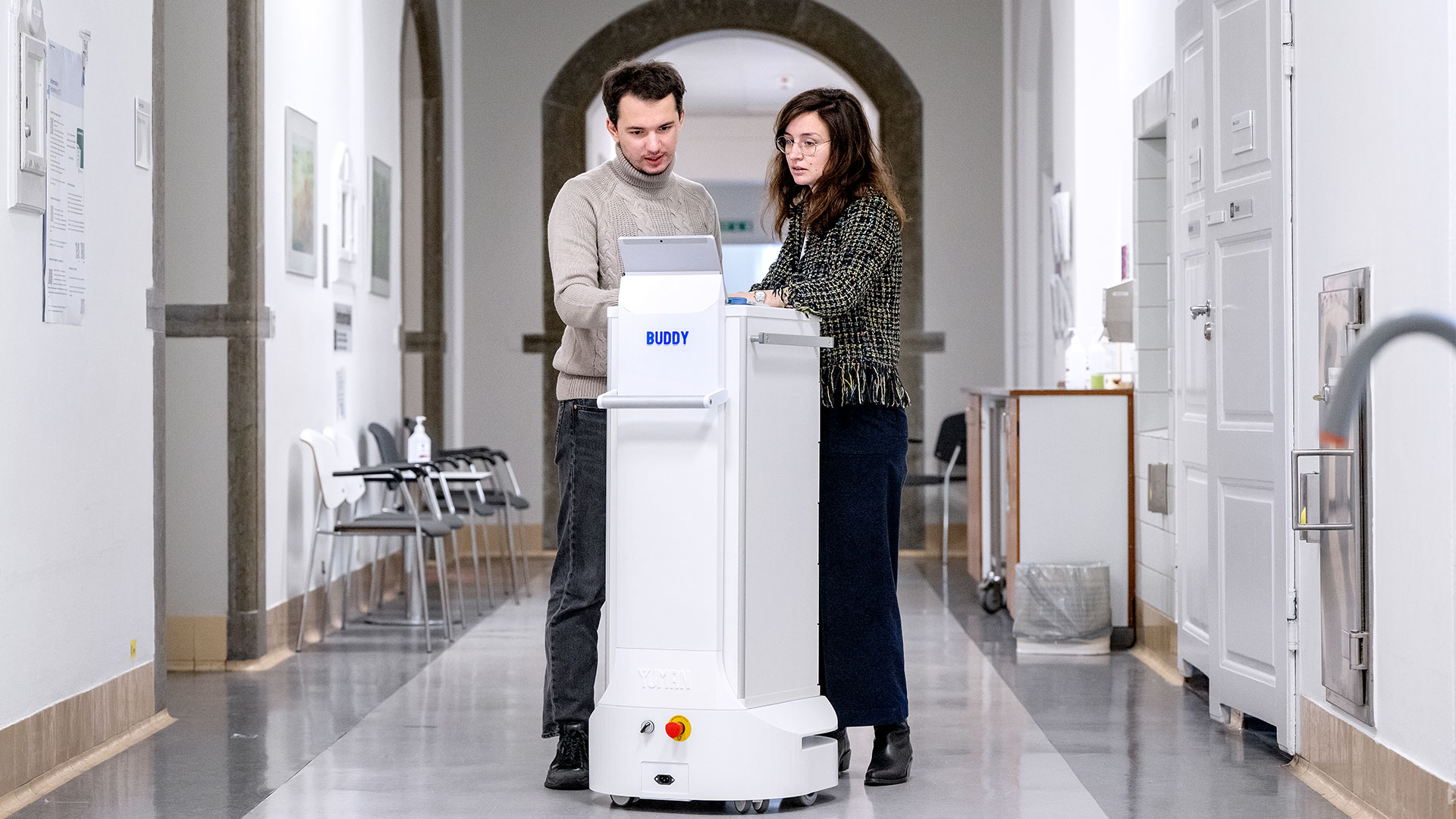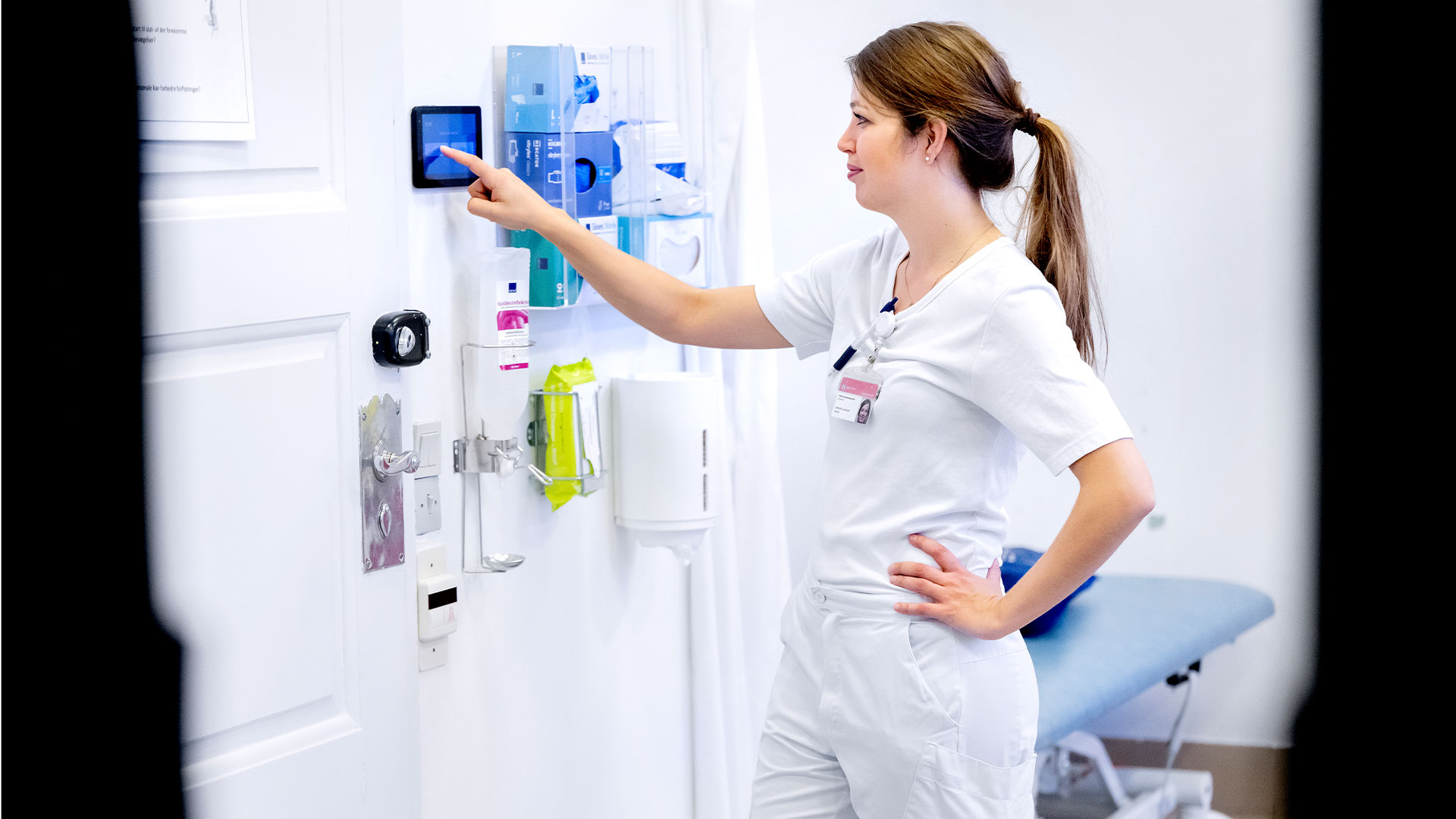Facts
Entrepreneurship
Robots lend nurses a helping hand
A robot developed by two DTU graduates brings equipment to nurses so they can concentrate on patient-related tasks that only they can perform. In this way, Buddy—which the duo has aptly called their robot—can help alleviate the nursing shortage.


The evolution of a robot
It was with this mission in mind that she and Yuman’s co-founder Andrei Chirtoaca started the company in early 2022 after meeting each other during their master’s studies at DTU. With a background in software engineering and spurred on by the opportunity to do an entrepreneurial thesis at DTU, they set about designing and building a robot tailored to the healthcare sector that meets nurses’ needs.
“When we started, we had no knowledge of the hardware side of things so that was a big challenge,” Sara Lopez Alaguero says. Through learning by doing, six months later the duo had built a prototype, which they have been maturing ever since to make sure it is spacious enough to carry what it needs (such as blood pressure monitors and peripheral venous catheters), but light enough to move around efficiently without running out of battery too quickly.
Buddy, as they have aptly named it, is based on the supply cabinets that nurses currently go and retrieve to bring to a patient’s bed. It is built bottom-up based on feedback from users and hospital needs and is controlled by a ‘brain’ that uses information, which sensors retrieve about its surroundings.
Since the company started two years ago, Buddy has undergone quite an evolution to make it sleeker, more efficient to run and quicker to brake if something crosses its path. The startup has also made vital changes to the way Buddy is controlled, so it doesn’t require any technical knowledge: Nurses can simply call it with just one click, directly from the patient rooms.
“We have made huge improvements and have managed to build something that nurses find easy and intuitive to use so it adapts to their workflow and doesn’t introduce unwanted changes to their routines,” Andrei Chirtoaca says.
While safety is paramount, Buddy also needs to move fast enough to be a viable alternative to nurses fetching supplies themselves. The complex task of balancing safety and speed has required the team to work extensively on the software and hardware that Buddy uses to get from A to B – regardless of the layout of a department.
“We need Buddy to be able to predict what will happen before it happens, so we don’t end up with awkward situations where nurses need to wait for it,” Sara Lopez Alaguero says.
Yuman’s business model is based on having one base model that can be varied according to needs. “That way hospitals do not need to buy 10 products, but one product that fits 10 needs—for example by adapting the robot for different purposes like bringing food or distributing supplies, but it’s essentially the same product,” Sara Lopez Alaguero explains.
Valuable pilot tests
Crucial to ensuring that Buddy becomes a useful part of a nurse’s work routine is that it is easy to call, carries the necessary equipment and arrives quickly and safely. To iron out any kinks in the design and to validate what the nurses need, Yuman has conducted a two-month pilot test at Capio Private Hospital and a four-month pilot test at the neurological department of the public Bispebjerg Hospital.
“Even when we asked the nurses ahead of time, they could only speculate on how they would use a robot—but when you are faced with the real product, it turns out to be different. We are using the feedback from the pilot to incorporate nurses’ feedback into Buddy and ensure nurses are happy. Because at the end of the day, it’s about the robot delivering value to the hospital,” Andrei Chirtoaca emphasizes. Changes made include the way in which the nurses call Buddy and how it navigates in the busy environment.
The evaluation reports from the pilot show that the nurses generally found it easy to use Buddy as part of their workflow. Doing so allowed the nurses at Bispebjerg Hospital to take 2,000 fewer steps (out of between 5,000 and 10,000) during a shift, freeing up time that can be spent with the patients. At Capio, where Buddy worked 57 days alongside the nurses, it gave them back a total of 74 hours of work, which equates to two weeks of full-time work.
To Clinical Nurse Specialist Johanne Laursen Lykke from Bispebjerg Hospital the main benefit provided by Buddy is that it allows the nurses to be fully present when dealing with their patients: “Because when you keep being interrupted, you might end up forgetting something.”
She sees great value in a robot assistant as long as it fits easily into existing workflows and does what you need it to do, which is why she appreciates Yuman’s willingness to listen to the nurses’ input:
“They have been willing to constantly adapt Buddy and make it as intuitive to use for us as possible.”
Since finishing the pilot test, one of the robots has stayed at Bispebjerg Hospital, and the department has requested funding to get more Buddies that can be used for different tasks.
Blood, sweat and tears
Getting the startup off the ground has required big sacrifices. While for the better part of a year the co-founders had a rent-free workspace at DTU Skylab with access to building materials and the expertise of their DTU lecturers, they also had no salary coming in. DTU Skylab is the university’s innovation hub where selected startups get the chance to grow their ideas in a 5500 square meter cross-disciplinary learning environment consisting of labs, workshops, auditoriums, open spaces, and project rooms.
“We took a big leap of faith. But we thought we would give it a try for a few months and if we were successful and received interest from hospitals and could raise some money, we would continue working on Buddy,” Sara Lopez Alaguero says.
Soon funding and accolades started rolling in. To name a few, Yuman was named Most Promising Robotics Startup in Europe 2022 by the European Robotics Forum and last year, the startup was named in Forbes Magazine’s 30 under 30 Europe list (which includes the most notable names under the age of thirty in different categories) for manufacturing and industry.
To date the company has raised more than 5.8 mio. DKK in public funding from Danish and European agencies – money that has enabled Yuman to move to premises outside of DTU and hire more permanent staff.
“I think all the variables in Denmark are set up perfectly for us to do this type of innovation. We are trying to shape the future of how robots are going to be adopted and it seems like the health care industry is looking at how it can improve itself for the future, so it’s a good match,” Andrei Chirtoaca says.

